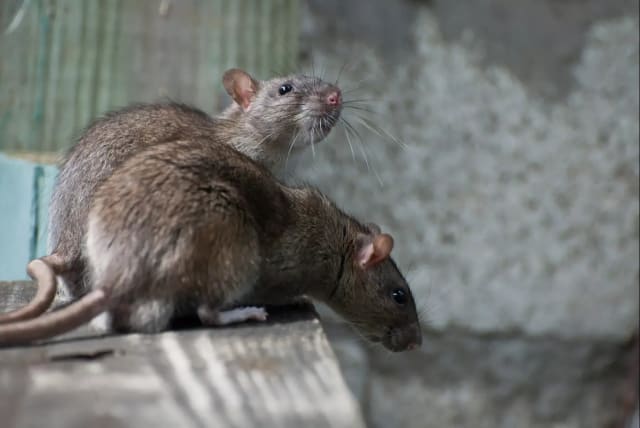Light rail construction may have caused rising flea-borne typhus cases in Tel Aviv

Light rail construction in Tel Aviv causes many problems, but this is one of the most worrying. What do we know about Murine typhus?
Light rail construction and digging in Tel Aviv may have resulted in a dramatic increase in the number of patients with Murine (flea-borne) typhus. Large numbers of rats and mice have emerged from underground and have started to roam the streets, which historically can lead to a rise in illness.
According to data from Holon's Wolfson Medical Center, between 2016 and 2021 only a single case of this disease was recorded. In 2022 and 2023, the years the construction began in the area, 16 cases were recorded. Sourasky Medical Center in Tel Aviv (Ichilov) also noted a similar trend and reported that in the past year and a half, there have been at least four cases of illness that are likely caused by rats and mice.
Dr. Yael Paran, a specialist in internal medicine and infectious diseases at Ichilov, explained that this is a significant increase in cases. In the past, there may have been years without any cases at all, and sometimes only one case in a given year.
Paran told Walla, "I assume that what we see in the hospital are just severe cases. This is a disease with a wide spectrum - from asymptomatic carriers, to a fever that can pass by itself, to a severe disease that can lead to hospitalization. I am convinced there are cases that resolve on their own or after treatment without a diagnosis being made."
Paran clarified that "The important thing is that doctors take the disease seriously, as there is a significant rise in cases in Tel Aviv and Bnei Brak. They must administer the appropriate tests to promptly diagnose it. In addition, the Health Ministry and local authorities should also make efforts to control the outbreak."
Is light rail construction really at fault?
At Wolfson Medical Center, a connection was indeed found between the work shifts of the light rail and the patients admitted.
"In the past two years, 16 patients arrived at the hospital, while five years earlier only one case was recorded. It is not a matter of attention or specific tests, but suddenly the disease has become common and there has been a dramatic increase," explained Prof. Yasmin Maor, head of the Infectious Diseases Unit at Wolfson Medical Center. "In terms of severity, not all patients who arrived at the hospital were critically ill, but some of them required intensive care. There are a lot of fleas in the Tel Aviv, Holon, and Bat Yam areas. And I know that even in Bnei Brak, there has been an increase in cases. Therefore, we asked ourselves what changed in this period.
"Dr. Iris Zohar, a senior doctor in the Infectious Diseases Unit, suggested a connection to the construction of the light rail. We saw that people with this disease live close to the railway construction sites. This is not a definitive proof, but it is a reasonable correlation.
"According to her, half of the people who arrived with the disease at the hospital reported that they had direct or indirect contact with fleas or mice, seen in the house or in the yard, and half of them did not. This is a reasonable correlation because some of the fleas move to the grass and jump on people who pass by.
"We also know that fleas transmit other diseases like the bubonic plague, and there are cases of people being bitten by fleas, so there is no doubt that efforts to control and reduce the number of fleas need to be increased," Paran concluded.
What is Murine typhus?
Murine typhus is a bacterial disease caused by bacteria from the Rickettsia family that is transmitted to humans by insects, mainly through flea or mite bites. Infection happens when a mite or flea sucks the blood of an infected animal, and then when it sucks a person's blood, it transmits the bacteria to them and infects them.
What are the symptoms of Murine typhus?
The symptoms of the disease range from a mild illness that passes without treatment, to a severe illness that can lead to complications such as systemic damage and even death. The main symptoms are a combination of high fever, headaches, and after a few days, the appearance of a rash that appears on the palms of the hands and the soles of the feet.
Symptoms of the disease can appear a few weeks after the bite, making it difficult to identify the connection between the bite and the disease. Diagnosis is based on a combination of symptoms and blood tests. When there is a high clinical suspicion, antibiotic treatment must be given automatically to prevent complications.
How is Murine typhus treated?
Treatment for the disease is relatively simple and includes antibiotics, usually doxycycline. It is used to treat infections caused by bacteria and other microorganisms.
Jerusalem Post Store
`; document.getElementById("linkPremium").innerHTML = cont; var divWithLink = document.getElementById("premium-link"); if (divWithLink !== null && divWithLink !== 'undefined') { divWithLink.style.border = "solid 1px #cb0f3e"; divWithLink.style.textAlign = "center"; divWithLink.style.marginBottom = "15px"; divWithLink.style.marginTop = "15px"; divWithLink.style.width = "100%"; divWithLink.style.backgroundColor = "#122952"; divWithLink.style.color = "#ffffff"; divWithLink.style.lineHeight = "1.5"; } } (function (v, i) { });

